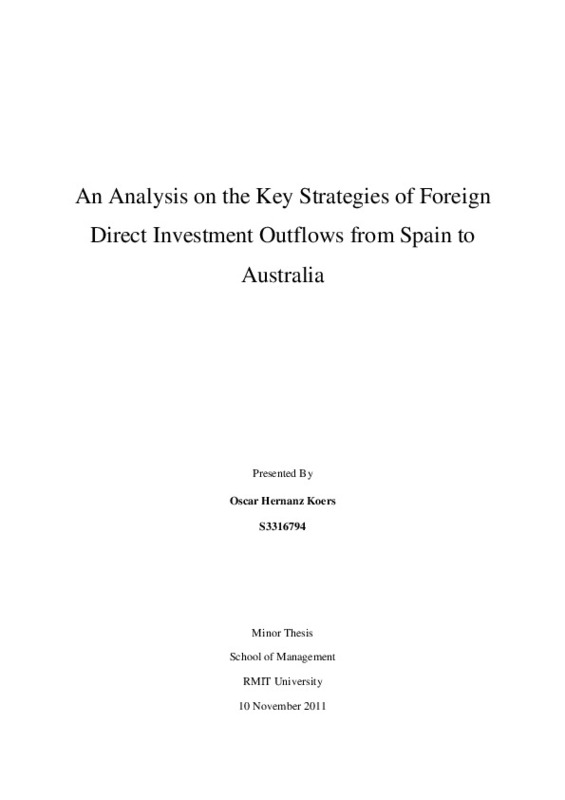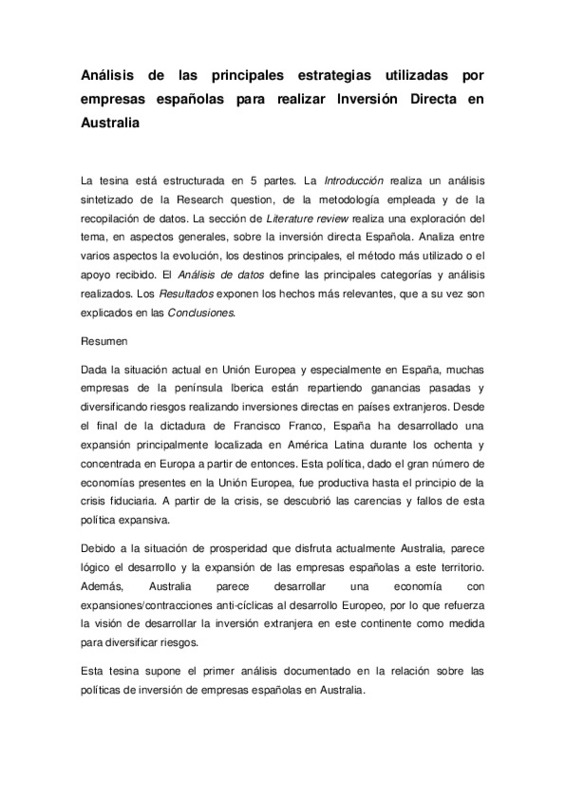JavaScript is disabled for your browser. Some features of this site may not work without it.
Buscar en RiuNet
Listar
Mi cuenta
Estadísticas
Ayuda RiuNet
Admin. UPV
An analysis on the key strategies of foreign direct investment outflows from Spain to Australia
Mostrar el registro sencillo del ítem
Ficheros en el ítem
| dc.contributor.advisor | Mees, Bernard
|
es_ES |
| dc.contributor.author | Hernanz Koers, Óscar
|
es_ES |
| dc.coverage.spatial | east=133.77513599999997; north=-25.274398; name=Ghan NT 0872, Austràlia | |
| dc.coverage.spatial | east=-3.7492200000000366; north=40.46366700000001; name=Autopista de Circunvalación M-30, 28023 Madrid, Espanya | |
| dc.date.accessioned | 2014-05-07T14:11:50Z | |
| dc.date.available | 2014-05-07T14:11:50Z | |
| dc.date.created | 2012-05-14 | |
| dc.date.issued | 2014-05-07 | |
| dc.identifier.uri | http://hdl.handle.net/10251/37291 | |
| dc.description.abstract | [EN] The establishing of the European Union (EU) has led to the creation of a stable economic market and a sense of political security in Europe that has made the EU popular among many business analysts. The ongoing development of the EU has brought many changes to the European economy and has also made it increasingly attractive for EU-based companies to pursue cross-border investment. The introduction of the Euro in 2002 as common currency, and a single monetary policy regime under the direction of the European Central Bank as well as the elimination of cross-border tariffs are just some examples of the benefits that companies in European member countries obtained with the formation of the EU. Nevertheless, the Euro area is currently evidencing the weaknesses and disadvantages of having to combine many different fiscal policies and business cycles under one monetary regime. The economic and financial crisis affecting the European Continent is challenging governments, countries and some multinational corporations. Multinationals mainly focused on Europe and its domestic markets are facing economic challenges that are reminiscent of those which obtained during the reconstruction period after the Second World War, suggesting a greater need to focus expansion and investment in markets outside Europe. Spanish investment allocations have recently mirrored an EU tendency for capital flight. For the last 35 years, Spanish Foreign Direct Investment (FDI) seems mostly to have followed a predetermined allocation shape, albeit with altered concentrations and amounts of capital allocated most Spanish corporations have only considered allocating funds to Central and South America or the rest of Europe in recent years. Yet allocating capital to Latin America involves many risk factors that need to be taken into account. Hence, many Spanish organizations have looked more recently for more secure opportunities for internationalization and therefore have tried to access European markets, where success stories seemed almost to be taken for granted. Taking the range of countries in the EU and their different stages of business cycles into account, investors assumed that there would always be some nations enjoying periods of economic growth and expansion. The reality has proven otherwise, however. Forming part of the so-called PIIGS (Portugal, Italy, Ireland, Greece and Spain) group of countries, Spain currently has one of the highest unemployment rates in the developed world, and suffers particularly high borrowing costs. It is not, therefore, currently likely to return to prosperity in the short-to-medium term. Due to the poor economic conditions which currently prevail in their home country, some Spanish corporations are presently aiming to achieve greater risk diversification in their operations though a resort to FDI activity other than in the EU or in the traditional destination of largely Spanish-speaking Latin America. Differing national economic prospects would seem to make Australia an appealing diversification opportunity for Spanish corporations. Fewer trading links, the physical distance and the rich natural resources of the country make Australias economy less influenced by movements in European markets. The impact and predominant determinants of the value of the Australian dollar (AUD) are significantly different to the ones which inform the value of the Euro (EUR), as the value of the Australian dollar has a high correlation to the market prices of locally produced commodities (natural gas, base minerals etc.), which are significantly affected by the demand of the developing economies of East Asia (Bloomberg 2011). There are factors discouraging Spanish investment in Australia as well, however. Physical and psychical distances (Beckerman 1956 & Linnemann 1966) are important factors that might discourage Spanish investment in Australia. Nonetheless, there have been a few Spanish corporations that have decided to allocate capital in the Antipodes. Analysing these investments is the main purpose of the work at hand. This thesis presents the first substantial analysis of Spanish FDI in Australia. The analysis is based on the Spanish investments in Australia which have occurred over the last 18 years and is mainly focused on seeking to ascertain the reasons why Spanish corporations have allocated capital to the Antipodes. Observing key variables (such as the value of investments and the allocation sector or type of FDI) together with a qualitative analysis of media releases allows a more concise and detailed understanding of the motivation for Spanish FDI. The investigation which follows will above all seek to discern whether FDI in Australia has been actually used in order to diversify risk or rather has developed only in an opportunistic and unstructured manner. | es_ES |
| dc.description.abstract | [ES] Dada la situación actual en Unión Europea y especialmente en España, muchas empresas de la península Iberica están repartiendo ganancias pasadas y diversificando riesgos realizando inversiones directas en países extranjeros. Desde el final de la dictadura de Francisco Franco, España ha desarrollado una expansión principalmente localizada en América Latina durante los ochenta y concentrada en Europa a partir de entonces. Esta política, dado el gran número de economías presentes en la Unión Europea, fue productiva hasta el principio de la crisis fiduciaria. A partir de la crisis, se descubrió las carencias y fallos de esta política expansiva. Debido a la situación de prosperidad que disfruta actualmente Australia, parece lógico el desarrollo y la expansión de las empresas españolas a este territorio. Además, Australia parece desarrollar una economía con expansiones/contracciones anti-cíclicas al desarrollo Europeo, por lo que refuerza la visión de desarrollar la inversión extranjera en este continente como medida para diversificar riesgos. Esta tesina supone el primer análisis documentado en la relación sobre las políticas de inversión de empresas españolas en Australia. | es_ES |
| dc.format.extent | 66 | es_ES |
| dc.language | Inglés | es_ES |
| dc.publisher | Universitat Politècnica de València | es_ES |
| dc.rights | Reserva de todos los derechos | es_ES |
| dc.subject | Comercio exterior | es_ES |
| dc.subject | Diversificación riesgo empresarial | es_ES |
| dc.subject | Inversión extranjera directa | es_ES |
| dc.subject | Inversión extranjera | es_ES |
| dc.subject | Inversión directa | es_ES |
| dc.subject | Australia | es_ES |
| dc.subject | España | es_ES |
| dc.subject.other | Licenciatura en Administración y Dirección de Empresas-Llicenciatura en Administració i Direcció d'Empreses | es_ES |
| dc.title | An analysis on the key strategies of foreign direct investment outflows from Spain to Australia | es_ES |
| dc.type | Proyecto/Trabajo fin de carrera/grado | es_ES |
| dc.rights.accessRights | Abierto | es_ES |
| dc.description.bibliographicCitation | Hernanz Koers, Ó. (2012). An Analysis on the Key Strategies of Foreign Direct Investment Outflows from Spain to Australia. http://hdl.handle.net/10251/37291. | es_ES |
| dc.description.accrualMethod | Archivo delegado | es_ES |
Este ítem aparece en la(s) siguiente(s) colección(ones)
-
ADE - Trabajos académicos [3699]
Facultad de Administración y Dirección de Empresas







